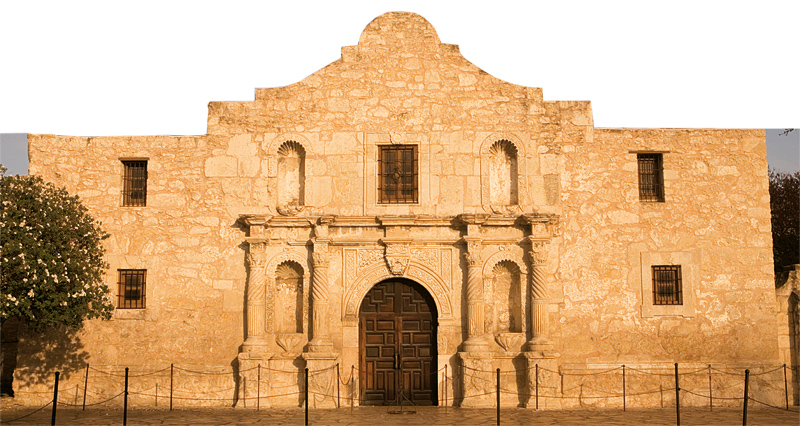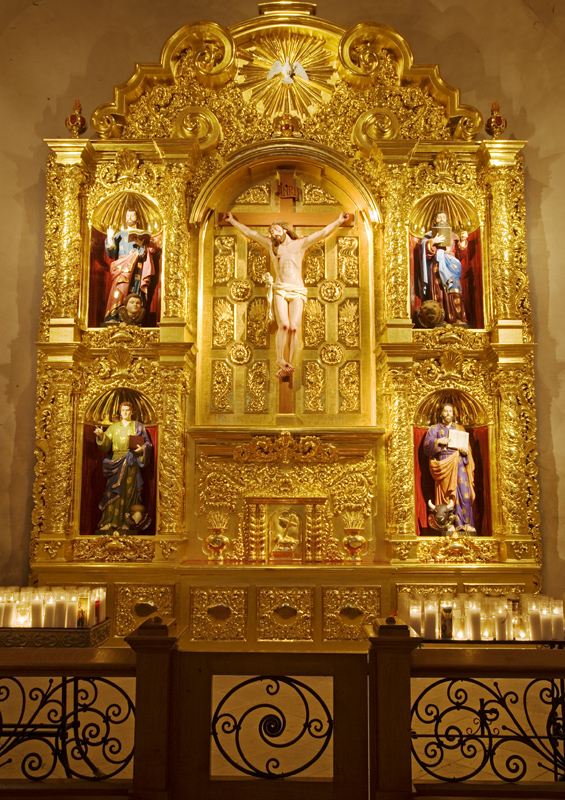 Historic Sites
Historic Sites
 The Alamo
The Alamo

Chapel facade, the Alamo
San Antonio’s first mission is best known for the 1836 Texas Revolution Battle. Established in 1718 midway between the Spanish capital in Santa Fe, New Mexico, and the missions of east Texas, by the 1830s it had become a Mexican military post (For further details see The Alamo).
 Menger Hotel
Menger Hotel
The oldest operating hotel in the city built by German immigrant William Menger, is noteworthy for its magnificent Victorian lobby with antique furnishings and paintings. Theodore Roosevelt stayed here in 1898, while he recruited Rough Riders to fight in Cuba during the Spanish-American War (For further details see Menger Hotel).
 Spanish Governor’s Palace
Spanish Governor’s Palace
Built before 1750, the palace was the presidio captain’s home and headquarters. From 1772 to 1782 it was the seat of Texas government for the Spanish Province. This expertly restored building, now a museum, displays antique furnishings.
- 105 Plaza de Armas
- 210 224 0601
- Open 9am–5pm Tue–Sat, 10am–5pm Sun
- Adm
- www.spanishgovernorspalace.org
 San Fernando Cathedral
San Fernando Cathedral

Retablo at San Fernando Cathedral
In February 1836, Mexican General Santa Anna raised a red flag from the top of this church to signal “no quarter, no surrender, and no mercy,” to the defenders of the Alamo. A sarcophagus here is believed to hold the remains of the defenders of the Alamo (For further details see San Fernando Cathedral).
 Military Plaza
Military Plaza
Until 1865, the Plaza de Armas was used as a parade ground, and for public executions and vigilante lynchings. It became a popular outdoor market after the Civil War, and in the evening young women, Chili Queens, cooked and served chili con carne to the townspeople.
- Bounded by Commerce St, Flores, Dolorosa, Spanish Governor’s Palace
 Main Plaza
Main Plaza
The first settlers, the Canary Islanders, set up homes around La Plaza de Las Islas (The Square of the Islands). A fiesta was held here to celebrate the crowning of King Ferdinand VI, and in 1845, Governor Sam Houston delivered his speech for union with the United States.
- Bounded by Commerce St, Soledad, Houston, Main Ave
 St. Joseph’s Downtown Church
St. Joseph’s Downtown Church
Founded by German Catholic immigrants, the cornerstone of this church was laid in 1868. In 1891, four bells with matching tones were donated, a church spire was added in 1898, and stained-glass windows from Munich installed in 1902. Today, the church is surrounded on three sides by the Rivercenter Mall. The exterior can most clearly be seen from the Tower of the Americas.
- 623 East Commerce St
- 210 227 0126
- Mass: 8am Mon, Wed & Fri (Spanish); 8am Tue & Thu (English); 6pm Sat (English); 8am, noon, 7pm Sun (Spanish)
 Mission San José
Mission San José
The largest and most beautiful of San Antonio’s Missions, San José was well-run and successful, earning it the title of the “Queen of Missions”. Its walls prevented attacks from marauding Native Americans in the 1700s. Texas’ oldest flour mill was built here around 1790. The mill still stands outside the north wall and grinds wheat using the original methods (For further details see San Antonio Missions National Historical Park).
 O. Henry House
O. Henry House
Renowned author William Sydney Porter 1862–1910 used the pen-name O. Henry. Best known for the ironic twists of plot in short stories such as The Gift of the Magi, he lived and wrote in this quaint limestone house during the 1880s and 1890s, using San Antonio as the setting for his famous stories Fog and The Enchanted Kiss. Displayed in the carefully restored building are period furnishings, articles, photographs, and works by the author.
- Dolorosa at Laredo
- www.ohenryhouse.org
 Casa Navarro State Historic Site
Casa Navarro State Historic Site
This restored residence was the home of José Antonio Navarro, signer of the 1836 Texas Declaration of Independence. The house, and his law office, all have period furnishings. A small museum traces his accomplishments as a lawyer, rancher, politician, and author. In the early 1840s he was captured and imprisoned in Mexico. He escaped to Cuba in 1845 and returned home in time to vote for the annexation of Texas to the United States.
- 228 S Laredo St
- 210 226 4801
- Open 9am–4pm Tue–Sun
- Adm